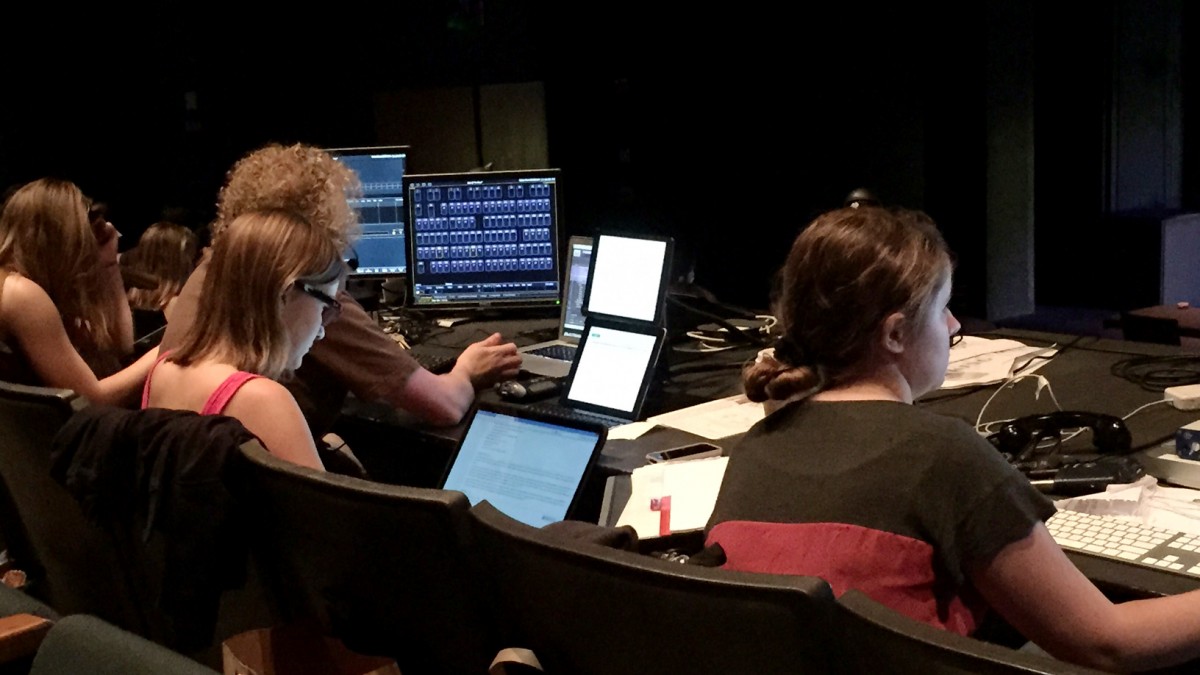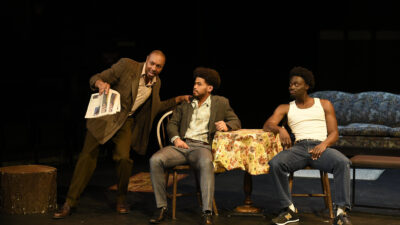
Students during tech of the USC School of Dramatic Arts production of Dark of the Moon.
Days before the opening of Dark of the Moon at the Bing Theatre on Oct. 9, Director of Productions Elsbeth M. Collins shares first-hand about the BFA production and tech.
There are a lot of perks for a faculty member in an academic theatre program. Among the chief ones, I would say, is the opportunity to observe the next generation at work, doing the work we have loved all our lives. This past weekend, I observed the tech for our current BFA production of Dark of the Moon by Howard Richardson and William Berney, directed by John DeMita, with choreography by Lili Fuller.
The design process began about two months ago, with initial discussions between the director and his designers: Scenic Designer Katrina Coulourides, Costume Designer Meagan Smith, Lighting Designer G. Austin Allen and Sound Designer Danielle Kisner.
Through research of the setting, shared via Dropbox, and in conversations together about the nature and arc of the play, the team developed a vocabulary about how to convey this tragic tale to a contemporary audience.
The play, set in the Appalachian mountain region in the late 1920s, is a dark and haunting work about the desire of a witch boy to become human in order to gain the love of a simple, if slatternly young woman, whose “pleasurings” with many men in the community has drawn the approbation of all, including her parents. His request to remain human teeters atop a wager that this young woman, Barbara Allen, can remain faithful to him throughout the course of one year.
My husband, Jimmie, told me that Dark of the Moon was the first play produced by The Circle In The Square back in 1951 in Greenwich Village. As an actor, Jimmie’s life and body of work in the theatre echoes all the time — an intimate circling back that happens so often in the theatre in which we are all related by our own passages through these timeless works.
The USC School of Dramatic Arts production is, I can safely say after watching the first dress, going to be gorgeous. All the student designers — save the scenic designer, who is a young professional about nine years out of school — have worked exhaustively over the past week to cue and refine the looks of the play, which is majestic in its imagery.
The other member of the team who has shaped this production with her strength and leadership is the stage manager, Alice Pollitt, a senior in the BFA Stage Management program, well on her way to becoming a professional in the field. Her calm demeanor, strong leadership and wry sense of humor have characterized the entire tech process, which was smooth and stress-free. Though much time was taken in the building of lights and sound — there are a lot of thunder and lightening cues in this show — the pace was measured and the timing of the cueing was extremely professionally executed. That night, Alice moved from the front of house tech table to the Stage Management podium off stage right, where she used a combination of the rather poor camera from front of house and a live view from the wings to call the complex cues. Nary a cue missed that I could see. Her book is in impeccable order for a first dress.
Director John DeMita has shaped this play with a strong visual sense of purpose and the multi-leveled set by Coulourides aids in the separation of man from witch. Fuller’s choreography of both the witch girls and the dances done by the townspeople further demarcate the boundaries between these two warring populations of Buck Creek. Allen’s strong and vivid lighting as well as the subtle and effective use of projections make the stage pictures striking (literally) and memorable. Kisner’s soundscape evokes the power of the natural and unnatural forces of this town and Smith’s costumes greatly enhance the spookier moments in the play.
But to circle back, a comment from Assistant Director Jay Lee in the dark of the tech filled my heart with the pride of seeing students seeking excellence in their craft. He turned to me and, with his usual impishly curious expression, said: “How do all your tech Padawans manage to do so well?” He was so pleased with the metaphor he had used, and I was so hopelessly clueless that I had to look it up. Geez. But he’s right — these theatre artists are on their way to being Jedi designers and stage managers. With Dark of the Moon behind them, I’d safely say, they are well on their way.
 About the writer: Elsbeth M. Collins is a veteran stage manager who leads the BFA Stage Management program at the USC School of Dramatic Arts and has also served as Director of Production since 2008. Prior to coming to USC, Collins worked as a professional stage manager for over 25 years. Her long list of credits include the Ahmanson Theatre, the Mark Taper Forum, the James A. Doolittle Theatre, the Geffen Playhouse, the Los Angeles Theatre Center, The Pasadena Playhouse, the Hollywood Bowl, the Alpine Theatre Project in Whitefish, Montana, La Mirada Theatre, and in Gibellina, Sicily, among others. Collins has worked with such noted artists as Al Pacino, Alan Alda, Victor Garber, Alfred Molina, Peter Falk and Jason Alexander, but relishes teaching the next generation of theatre artists: actors, designers, stage managers and technical directors.
About the writer: Elsbeth M. Collins is a veteran stage manager who leads the BFA Stage Management program at the USC School of Dramatic Arts and has also served as Director of Production since 2008. Prior to coming to USC, Collins worked as a professional stage manager for over 25 years. Her long list of credits include the Ahmanson Theatre, the Mark Taper Forum, the James A. Doolittle Theatre, the Geffen Playhouse, the Los Angeles Theatre Center, The Pasadena Playhouse, the Hollywood Bowl, the Alpine Theatre Project in Whitefish, Montana, La Mirada Theatre, and in Gibellina, Sicily, among others. Collins has worked with such noted artists as Al Pacino, Alan Alda, Victor Garber, Alfred Molina, Peter Falk and Jason Alexander, but relishes teaching the next generation of theatre artists: actors, designers, stage managers and technical directors.



